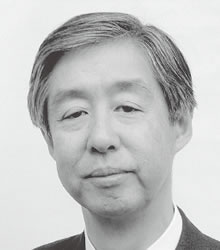2005年比較腫瘍学常陸宮賞受賞者
The Awardee of the 2005 Prince Hitachi Prize
for Comparative Oncology
"The role of proto-oncogenes in cell cycle control during meiotic maturation in starfish oocytes"
ヒトデ卵におけるプロトオンコジンによる胚発生の制御
 岸本健雄 博士
岸本健雄 博士
東京工業大学教授
Professor Dr. Takeo Kishimoto
Laboratory of Cell and Developmental Biology
Department of Biological Information
Graduate School of Bioscience and Biotechnology
Tokyo Institute of Technology
略歴
岸本健雄博士は、1947年7月3日、兵庫県伊丹市に生まれた。1971年6月に東京大学理学部化学科を卒業した。同年7月に同大学院理学系研究科動物学専攻修士課程に進学し、金谷晴夫助教授(東京大学海洋研究所)のもとでヒトデを使った生殖生物学の研究を開始した。1976年3月に同専攻博士課程を修了し、「ヒトデ卵の成熟機構に関する研究」で理学博士を授与された。1978年1月には基礎生物学研究所助手となり、金谷晴夫教授のもとでMPF(卵成熟/M期促進因子)の研究に従事した。1987年7月には同研究所助教授、同年12月には東京工業大学教授(理学部生物学教室)となり、M期制御に関する分子細胞生物学的研究を開始した。同大学内の改組に伴い、1990年6月に生命理工学部教授(生体機構学科発生生物学講座)、1999年4月からは大学院生命理工学研究科教授(生命情報専攻分子生命医科学講座)となり、卵減数分裂周期の制御機構およびゲノムの世代間継承に関する研究を推進している。この間、1993年11月には「卵細胞を用いた細胞複製機構の研究」で日本動物学会賞を受賞し、1996年4月から2001年3月までは科学技術振興事業団戦略的基礎研究(CREST)”生命活動のプログラム”領域で研究課題「細胞増殖の制御機構:シグナル伝達から細胞複製まで」の研究代表者、2000年5月から2004年4月まではHuman Frontier Science Program(HFSP)研究グラント「Signal Transduction during Oocyte Maturation」の研究分担者をつとめた。
Outline of Personal History
Takeo Kishimoto was born on 3 July 1947 in Itami City, Hyogo, Japan. He graduated from the Department of Chemistry, Faculty of Science, University of Tokyo in 1971. He then moved to the Zoological Institute, Graduate School of Science, University of Tokyo and started his study under the supervision of Associate Professor Haruo Kanatani of the Ocean Research Institute. In 1976, he finished the graduate course and was granted a Doctor of Science under the thesis of "Mechanism of Starfish Oocyte Maturation". After a post-doctoral fellow of the Japan Society for the Promotion of Science, he was appointed in 1978 Research Associate in the National Institute for Basic Biology, Okazaki, Aichi, Japan. He worked as a research collaborator with Prof. H. Kanatani of the Department of Developmental Biology. In 1987, he was promoted in July to Associate Professor at the same Institute, and then in December to Professor of biology at Tokyo Institute of Technology. At the founding of the new Faculty of Bioscience and Biotechnology in Tokyo Institute of Technology in 1990, he was appointed Professor of the Laboratory of Cell and Developmental Biology. Since the reorganization in Tokyo Institute of Technology in 1999, he has been appointed Professor of the same laboratory in Department of Biological Information, Graduate School of Bioscience and Biotechnology. In 1993, he was awarded the Zoological Society Prize from the Zoological Society of Japan under the title of "Cell Reproduction Control Revealed by Oocyte System". During 1996 to 2001, he served as the principal investigator of the Core Research Project for Evolutional Science and Technology (CREST) granted by the Japan Science and Technology Corporation (JST), entitled "Cell Proliferation Control: From Signal Transduction to Cell Duplication". During 2000 to 2004, he served as a co-investigator in the Human Frontier Science Program (HFSP) Research Grant, entitled "Signal Transduction during Oocyte Maturation".
研究業績
岸本健雄博士は、故金谷晴夫博士(当時、東京大学海洋研究所助教授)の下でヒトデ卵成熟誘起機構の解析にたずさわることから研究を開始した。そして、卵成熟誘起ホルモンは、卵表に受容されたのち、卵細胞質中のMPF(maturation-promoting factor、卵成熟促進因子)を介してその作用を発揮することを見出して、1976年に理学博士の学位を授与された。
1977年からは、愛知県岡崎市に創設された基礎生物学研究所に移り、金谷教授の助手としてMPFの解析を進め、MPFは、単に卵成熟誘起ホルモン作用の仲介因子であるだけではなく、全真核細胞に普遍的なM期誘起因子(M-phase promoting factor、MPF)でもあることを明らかにした。これにより、MPFの研究は、卵成熟に関わる内分泌学の課題から、M期(分裂期)制御に関わる細胞生物学の課題へと発展し、細胞周期制御の分子細胞生物学的研究が1980年代末から飛躍的に展開するための基礎が確立された。
岸本博士は、1987年に東京工業大学教授に就任し、M期制御に関する研究を推進した。当時は細胞周期制御研究が世界的に躍進した時期であったが、この中にあって同博士は、M期開始時に、MPF活性を担うCdc2キナーゼ(サイクリンB-Cdc2複合体)が細胞質から核内へ細胞内局在を移すことや、このキナーゼの染色体凝縮や紡錘体形成における役割、および、この複合体の解離におけるプロテアソームの機能などを次々と明らかにした。これらは、Cdc2キナーゼの細胞内での動態と機能の解析に関し、他の追随を許さない発見であった。
この生きた細胞の中で起こっていることを追求するという視点を軸として、岸本博士の研究は、1990年代後半から、M期制御から卵細胞システムへと回帰していった。すなわち、同博士は、卵成熟誘起ホルモンがどのようしてCdc2キナーゼの活性化をもたらして卵減数分裂周期を進め、その後いかにして卵細胞は受精を待つのか、つまり、胚発生を開始するための準備についての諸問題を、細胞周期制御を手掛かりとして解明することを目指した。その結果、Akt/PKB(protein kinase B)とMosという2種のプロトオンコジン産物がこれらの現象の鍵となる役割を担っていることが判明した。すなわち、第一に、Akt/PKBが、ヒトデ卵において、卵成熟誘起ホルモンの情報を卵細胞質内でCdc2キナーゼに伝達する際の鍵因子であることの発見である。これは、卵成熟誘起ホルモンからCdc2キナーゼに至るシグナル伝達の全経路を解明したものとして、全生物種を通じて最初のものである。さらに、従来から脊椎動物細胞でいわれていた細胞死回避作用とは全く別に、卵減数第一分裂におけるM期開始の引金という新規の役割をAkt/PKBに付与するものでもある。第二に、Mos-MAPキナーゼ経路が、脊椎動物だけでなく、無脊椎動物であるヒトデの卵細胞にも存在することの発見である。これにより、Mosは、卵減数分裂においてM期を連続させることによってゲノムの半減を実現させるとともに、そのあとの受精前の細胞周期を停止させ、単為発生を抑制するという、全後口動物に普遍的な役割が明らかにされた。
岸本博士の研究成果は、卵成熟と受精前の待機に関する生物学上の古典的かつ重要な命題についての今日的解答であり、しかも、その鍵が2つのプロトオンコジン産物にあるという知見は、比較腫瘍学研究の分野に新たな境地を開くものである。
Academic Achievement
Dr. Takeo Kishimoto started his study in 1971 as a graduate student of the late Dr. Haruo Kanatani, working on the endocrinology of starfish oocyte maturation. He was granted his Ph. D. in 1976; his thesis work demonstrated a maturation-promoting factor (MPF) in starfish oocytes, a cytoplasmic factor that transmits the maturation-inducing hormonal signal from the oocyte surface to the nucleus.
Around 1980, as a colleague of Prof. Kanatani, Dr. Kishimoto's research established the concept that MPF is not restricted to oocyte maturation but is a universal M-phase inducer in eukaryotic cells. Thus MPF became an issue not just in reproductive endocrinology but also in cell biology, and formed a base for the big bang of cell cycle research that started at the end of 1980's.
In 1987, Dr. Kishimoto was promoted to Professor of Biology at Tokyo Institute of Technology. At this time, knowledge of MPF, Cdc2, and cyclin B was converging to indicate that cyclin B-Cdc2 kinase constitutes MPF activity. Dr. Kishimoto demonstrated the translocation of cyclin B-Cdc2 kinase from the cytoplasm into the nucleus at the G2/M-phase transition, the non-essential role of histone H1 in chromosome condensation, the role of MAP (microtubule-associated protein) phosphorylation by cyclin B-Cdc2 kinase in assembling the mitotic spindle, and the non-proteolytic role of the proteasome in dissociating Cdc2 from cyclin B at exit from M-phase. These studies made essential contributions to understanding of the M-phase control in vivo by cyclin B-Cdc2 kinase.
From the mid 1990's to the present, Dr. Kishimoto's major interests have come back to the oocyte system, in starfish and frog. He recognized that despite the understanding of the outline of cell cycle control, it was still unclear how the meiotic cell cycle is controlled and how fertilization initiates the embryonic cell cycle. His studies showed that the proto-oncogene product Akt/PKB (protein kinase B) links extracellular hormonal action to the activation of cyclin B-Cdc2 kinase at induction of starfish oocyte maturation. This finding revealed the whole signalling pathway that leads to meiotic reinitiation, and in addition, identified Akt/PKB, which had been known as a transducer of cell survival signalling, as a new M-phase initiator. He further demonstrated in starfish oocytes that another proto-oncogene product, Mos, causes the second meiotic division to occur immediately after the first meiotic division, and then causes G1-phase arrest unless fertilization occurs. Based on this, he proposed a generalized role for Mos in invertebrate and vertebrate oocytes, both in accomplishing the genomic reduction and then in causing the cell cycle arrest to prevent parthenogenetic activation.
Dr. Kishimoto thus discovered that two proto-oncogene products, Akt/PKB and Mos, play key roles throughout the meiotic cell cycles, ensuring faithful initiation of embryonic development upon fertilization. These findings provide new insights into the historical and essential question in biology of how fertilization induces embryonic development, and also contribute a novel concept to comparative oncology.

